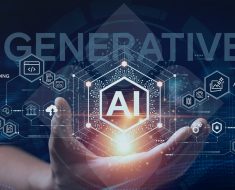Artificial Intelligence (AI) is everywhere. From smart assistants to self-driving cars, AI systems are transforming our lives and businesses. But what if there was an AI that could do more than perform specific tasks? What if there was a type of AI that could learn and think like a human or even surpass human intelligence?
This is the vision of Artificial General Intelligence (AGI), a hypothetical form of AI that has the potential to accomplish any intellectual task that humans can. AGI is often contrasted with Artificial Narrow Intelligence (ANI), the current state of AI that can only excel at one or a few domains, such as playing chess or recognizing faces. AGI, on the other hand, would have the ability to understand and reason across multiple domains, such as language, logic, creativity, common sense, and emotion.
AGI is not a new concept. It has been the guiding vision of AI research since the earliest days and remains its most divisive idea. Some AI enthusiasts believe that AGI is inevitable and imminent and will lead to a new technological and social progress era. Others are more skeptical and cautious and warn of the ethical and existential risks of creating and controlling such a powerful and unpredictable entity.
But how close are we to achieving AGI, and does it even make sense to try? This is, in fact, an important question whose answer may provide a reality check for AI enthusiasts who are eager to witness the era of superhuman intelligence.
What Is AGI and How Is It Different From AI?
AGI stands apart from current AI by its capacity to perform any intellectual task that humans can, if not surpass them. This distinction is in terms of several key features, including:
- abstract thinking
- the ability to generalize from specific instances
- drawing from diverse background knowledge
- utilizing common sense and consciousness for decision-making
- understanding causation rather than just correlation
- effective communication and interaction with humans and other agents.
While these features are vital for achieving human-like or superhuman intelligence, they remain hard to capture for current AI systems.
Current AI predominantly relies on machine learning, a branch of computer science that enables machines to learn from data and experiences. Machine learning operates through supervised, unsupervised, and reinforcement learning.
Supervised learning involves machines learning from labeled data to predict or classify new data. Unsupervised learning involves finding patterns in unlabeled data, while reinforcement learning centers around learning from actions and feedback, optimizing for rewards, or minimizing costs.
Despite achieving remarkable results in areas like computer vision and natural language processing, current AI systems are constrained by the quality and quantity of training data, predefined algorithms, and specific optimization objectives. They often need help with adaptability, especially in novel situations, and more transparency in explaining their reasoning.
In contrast, AGI is envisioned to be free from these limitations and would not rely on predefined data, algorithms, or objectives but instead on its own learning and thinking capabilities. Moreover, AGI could acquire and integrate knowledge from diverse sources and domains, applying it seamlessly to new and varied tasks. Furthermore, AGI would excel in reasoning, communication, understanding, and manipulating the world and itself.
What Are the Challenges and Approaches to Achieving AGI?
Realizing AGI poses considerable challenges encompassing technical, conceptual, and ethical dimensions.
For example, defining and measuring intelligence, including components like memory, attention, creativity, and emotion, is a fundamental hurdle. Additionally, modeling and simulating the human brain’s functions, such as perception, cognition, and emotion, present complex challenges.
Moreover, critical challenges include designing and implementing scalable, generalizable learning and reasoning algorithms and architectures. Ensuring the safety, reliability, and accountability of AGI systems in their interactions with humans and other agents and aligning the values and goals of AGI systems with those of society is also of utmost importance.
Various research directions and paradigms have been proposed and explored in the pursuit of AGI, each with strengths and limitations. Symbolic AI, a classical approach using logic and symbols for knowledge representation and manipulation, excels in abstract and structured problems like mathematics and chess but needs help scaling and integrating sensory and motor data.
Likewise, Connectionist AI, a modern approach employing neural networks and deep learning to process large amounts of data, excels in complex and noisy domains like vision and language but needs help interpreting and generalizations.
Hybrid AI combines symbolic and connectionist AI to leverage its strengths and overcome weaknesses, aiming for more robust and versatile systems. Similarly, Evolutionary AI uses evolutionary algorithms and genetic programming to evolve AI systems through natural selection, seeking novel and optimal solutions unconstrained by human design.
Lastly, Neuromorphic AI utilizes neuromorphic hardware and software to emulate biological neural systems, aiming for more efficient and realistic brain models and enabling natural interactions with humans and agents.
These are not the only approaches to AGI but some of the most prominent and promising ones. Each approach has advantages and disadvantages, and they still need to achieve the generality and intelligence that AGI requires.
AGI Examples and Applications
While AGI has not been achieved yet, some notable examples of AI systems exhibit certain aspects or features reminiscent of AGI, contributing to the vision of eventual AGI attainment. These examples represent strides toward AGI by showcasing specific capabilities:
AlphaZero, developed by DeepMind, is a reinforcement learning system that autonomously learns to play chess, shogi and Go without human knowledge or guidance. Demonstrating superhuman proficiency, AlphaZero also introduces innovative strategies that challenge conventional wisdom.
Similarly, OpenAI’s GPT-3 generates coherent and diverse texts across various topics and tasks. Capable of answering questions, composing essays, and mimicking different writing styles, GPT-3 displays versatility, although within certain limits.
Likewise, NEAT, an evolutionary algorithm created by Kenneth Stanley and Risto Miikkulainen, evolves neural networks for tasks such as robot control, game playing, and image generation. NEAT’s ability to evolve network structure and function produces novel and complex solutions not predefined by human programmers.
While these examples illustrate progress toward AGI, they also underscore existing limitations and gaps that necessitate further exploration and development in pursuing true AGI.
AGI Implications and Risks
AGI poses scientific, technological, social, and ethical challenges with profound implications. Economically, it may create opportunities and disrupt existing markets, potentially increasing inequality. While improving education and health, AGI may introduce new challenges and risks.
Ethically, it could promote new norms, cooperation, and empathy and introduce conflicts, competition, and cruelty. AGI may question existing meanings and purposes, expand knowledge, and redefine human nature and destiny. Therefore, stakeholders must consider and address these implications and risks, including researchers, developers, policymakers, educators, and citizens.
The Bottom Line
AGI stands at the forefront of AI research, promising a level of intellect surpassing human capabilities. While the vision captivates enthusiasts, challenges persist in realizing this goal. Current AI, excelling in specific domains, must meet AGI’s expansive potential.
Numerous approaches, from symbolic and connectionist AI to neuromorphic models, strive for AGI realization. Notable examples like AlphaZero and GPT-3 showcase advancements, yet true AGI remains elusive. With economic, ethical, and existential implications, the journey to AGI demands collective attention and responsible exploration.







